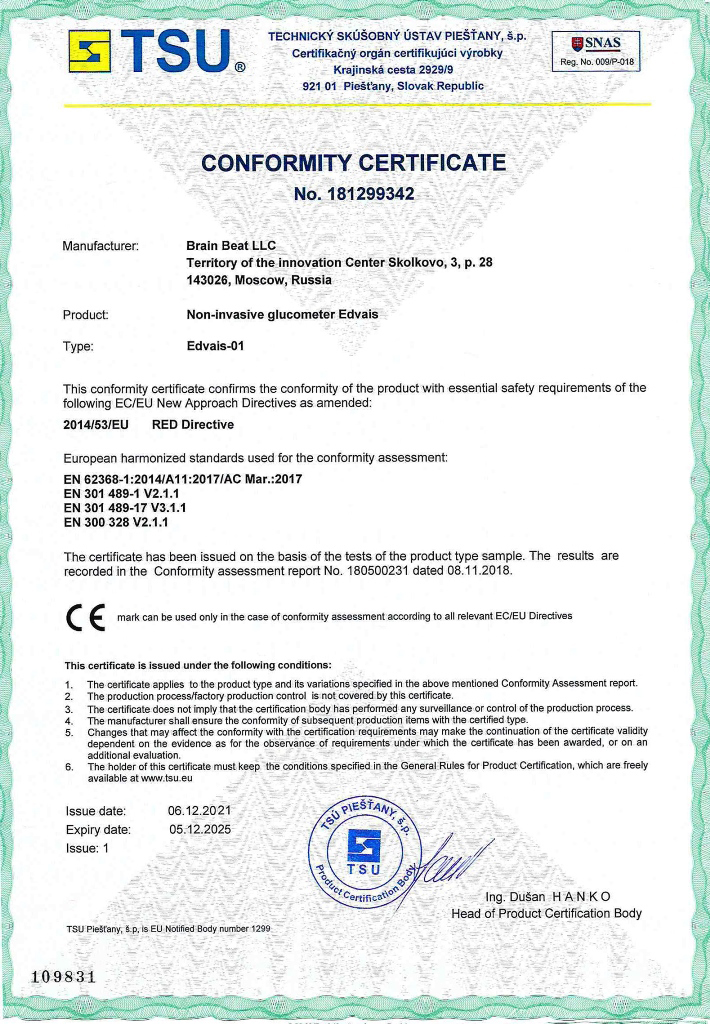TECHNOLOGY
ABOUT METHOD

463 million people in the world suffer from diabetes mellitus in 2019, according to statistics from the International Diabetes Federation (IDF). To control blood sugar levels, a diabetic daily punctures his fingers (and other parts of the body) through pain and the risk of infection from 2 to 8 times. To improve the quality of life of patients with diabetes mellitus, it is necessary to create non-invasive glucose meters, i.e. glucose meters that do not require receiving a drop of blood or other biological fluids.
In this regard, non-invasive and inexpensive devices for indirect determination of blood sugar levels are of considerable interest.
To date, there is no universally recognized mass-produced non-invasive blood glucose meter in the world.
The most promising method of noninvasive glucometry, as noted at the 61st annual scientific session of the American Diabetes Association, is spectral, based on the achievements of spectroscopy in the near infrared range.
Three maxima are characteristic in the optical range of the glucose absorption spectrum: 840 nm, 940 nm and 1045 nm.
Measurements at these maxima are hindered by: the absorption of human skin, the absorption of water contained in different layers of the skin, melanin and the presence of other components that make up its composition.
Special LEDs and photodetectors were used for this area.
The formula that takes into account the influence of these factors and secretes the component of glucose in the blood is the know-how of our development and is patented.
The uniqueness of our project lies in the non-invasive spectroscopic measurement of glucose in the blood, based on specially developed algorithms that take into account a wide range of possible errors (caused, among other things, by the presence of other components at significant frequencies) during measurement.
The novelty lies in the calculation of glucose in the blood based on the measurement of radiation in the optical region of the glucose absorption spectrum at 3 bands.
In this regard, non-invasive and inexpensive devices for indirect determination of blood sugar levels are of considerable interest.
To date, there is no universally recognized mass-produced non-invasive blood glucose meter in the world.
The most promising method of noninvasive glucometry, as noted at the 61st annual scientific session of the American Diabetes Association, is spectral, based on the achievements of spectroscopy in the near infrared range.
Three maxima are characteristic in the optical range of the glucose absorption spectrum: 840 nm, 940 nm and 1045 nm.
Measurements at these maxima are hindered by: the absorption of human skin, the absorption of water contained in different layers of the skin, melanin and the presence of other components that make up its composition.
Special LEDs and photodetectors were used for this area.
The formula that takes into account the influence of these factors and secretes the component of glucose in the blood is the know-how of our development and is patented.
The uniqueness of our project lies in the non-invasive spectroscopic measurement of glucose in the blood, based on specially developed algorithms that take into account a wide range of possible errors (caused, among other things, by the presence of other components at significant frequencies) during measurement.
The novelty lies in the calculation of glucose in the blood based on the measurement of radiation in the optical region of the glucose absorption spectrum at 3 bands.
- Filtration on the absorption spectra of water, etc.
- Receiving data from photosensors up to several dozen measurements per second.
- The use of custom LEDs.
History
and plan
2014-2016
The stage of idea and concept testing
2016
2017-2018
2019-2020
2021-2025
Intellectual property
Patents and Certificates






